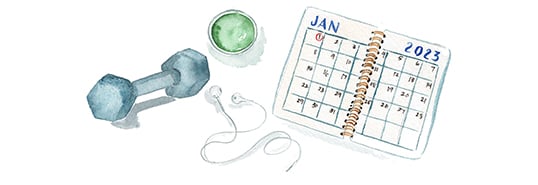Articles
The Science Behind Making Healthy Habits Stick
It’s a new year. A time to celebrate! A time for resolutions! A time to drink juice!
Each new year feels like a natural time to reset. In fact, humans have been doing it for thousands of years, according to History.com.1 The ancient Babylonians are likely the first people to make New Year’s resolutions about 4,000 years ago.
If you’re looking to make changes to your health or lifestyle, you’re not alone.
Almost 40 percent of U.S. adults made New Year’s resolutions for 2022, according to the Global Consumer Survey conducted by Statista for 2022.2
The report found that the top resolutions were focused on eating healthier and exercising more— no surprises there. Plus, a small portion of resolutions were related to greater well-being such as “spending less time on social media” and “reducing stress at work.”
Whether you want to drink more juice in the new year, make time for more self-care or get moving, it’s important to learn more about how you can make healthy habits stick.
Research conducted by Strava, a social network for athletes, found that most folks break their resolutions by January 12. The app analyzed more than 31.5 million activities throughout the globe, which helped determine the date when most people abandon their New Year’s goals.
“Sticking to resolutions is hard and we all know there’s a lot of talk and pressure in January about getting fitter and being healthier,” Gareth Mills, country manager for Strava in the U.K., told The Independent.3

Rituals, Defined
At Nama, we use the term ritual when talking about building healthy habits. Our mission is to help nurture wellness rituals through connecting with food, nature and our communities.
You can define a ritual in many ways but two great definitions are:
• a ceremonial act or action
• an act or series of acts regularly repeated in a set precise manner
Perhaps this year instead of making New Year’s resolutions, you can consider creating new (or revisiting old) rituals. These small, regular habits can keep you healthy and infuse your day with more delight.

How Journaling Helps
Writing in a blog post for Harvard Health, Dr. Marcelo Campos, a lecturer at Harvard Medical School, discussed how writing goals down can help you achieve them because it feels like more of a commitment.4
He explained that answering five specific questions can give you a push in the right direction when it comes to sticking to New Year’s resolutions.
The questions are:
1. Why do you want to make the change?
2. Is your goal concrete and measurable?
3. What is your plan?
4. Who can support you as you work toward change?
5. How will you celebrate your victories?
Research supports that journaling can have other health benefits too.
A recent study followed patients, families and healthcare practitioners who engaged in a journaling exercise called the “three-minute mental makeover.”5 Participants from a Chicago-area children’s hospital were led through a short writing exercise where they wrote from three prompts:
• write three things you’re grateful for
• write the story of your life in six words
• write three wishes you have
Study participants reported a reduction in stress levels after completing this journaling exercise, and researchers reported that writing was helpful even for people who had not used journaling in the past.
In a follow-up study, 85 percent of participants confirmed that they found the writing exercise helpful, and more than 50 percent said they continued to use writing as a means to cope with stress.6
If writing is not for you, tons of other research-backed tips can help you create new rituals around your health—and help them stay beyond the first week or two of January.

The Science of Self-Compassion
Dr. Laurie Santos, a professor of psychology at Yale and host of “The Happiness Lab” podcast, has spent many years teaching simple science-backed tips to improve well-being.
“The season of New Year's resolutions can be a time when it’s easy to beat yourself up,” she wrote in a recent Newsweek article.7 “We shame ourselves like an inner drill sergeant by ruminating on how badly we’ve done in the past year and how we need to turn things around for the new year. Or else.”
Her research has found that listening to that inner drill sergeant isn’t all that motivating.
“Harsh self-criticism and unrealistic expectations will destroy your morale and make you give up before you even begin,” she writes. “A better strategy for the new year is to extend yourself some kindness, or what psychologists call self-compassion.”
Self-compassion or being kind to yourself, isn’t just about feeling good; it’s a surprisingly effective way to reach your goals.
Dr. Kristin Neff, an associate professor in educational psychology at the University of Texas at Austin, and her colleagues, found that this kind of caring self-talk can help us eat healthier and exercise more.8
Neff says, “having compassion for oneself is really no different than having compassion for others,” and that it, “involves acting the same way toward yourself when you are having a difficult time, fail, or notice something you don’t like about yourself.”
Her work classifies self-compassion into three parts: self-kindness, common humanity, and mindfulness.9
• Self-kindness is all about being warm and understanding toward yourself when you suffer, fail, or feel inadequate, rather than ignoring your pain. It’s remembering to recognize that being imperfect, failing, and experiencing life difficulties is inevitable.
• Common humanity is all about community. It acknowledges that suffering and personal inadequacy is part of the shared human experience—something that everyone goes through.
• Mindfulness is a non-judgmental, receptive mind state in which one observes thoughts and feelings as they are, without trying to suppress or deny them. You cannot ignore your pain and feel compassion for it at the same time. Mindfulness helps you take a balanced approach to negative emotions so that feelings are neither suppressed nor exaggerated.
For more tips on self-compassion, check out these guided practices and exercises.

Social Solutions
Being kind to yourself is not the only way to feel your best in the new year; you can also practice being kind to others.
Research shows that you feel a boost in happiness when you do something nice for others.10
One way to apply this concept to resolutions is to not just make ones for yourself but to take time to check in with a friend, partner or family member about their goals too.
“Doing kind things for others is a surprisingly effective way of boosting our own well-being,” Santos writes. You might think of resolutions as a solitary act, but how can you make it more fun and social to reach health goals?
Santos explains that one of the primary ways we can improve happiness is by spending time with others.
“Our minds have really bad intuition about what we should do to become happier and feel better,” she writes. “So even when we put in some work to improve our well-being, we often wind up doing it wrong.”
Imagine the end of a long work day. You just want to go home, plop on the couch and maybe eat a pizza. That’s an example of looking to your mind for a way to feel good versus what research-backed information has found. The science says that spending time with others can help improve happiness.
Psychologists Ed Diener and Martin Seligman found in their research one definitive act that sets happy people apart from everyone else—happy people are more social.11
Of course, not everyone is going to feel happy at a large gathering, but what does connecting with others look like to you?
You could invite a friend over to make juice and go for a walk. How about taking a dance class with your partner as a date night activity or going bowling? Maybe you want to start a garden this spring and you can ask one of your parents, who has gardening knowledge, to help you plan it or pick out seeds.

Gratifying Goals
Another surprising way to stick with your resolutions is to focus less on the long-term benefits and instead work on ways to make the new habit or ritual immediately enjoyable.
Sounds too good to be true?
Not according to award-winning Wharton professor and “Choiceology” podcast host Katy Milkman, who has devoted her career to the study of behavior change. In her book, How to Change: The Science of Getting From Where You Are To Where You Want to Be, she gives this exact advice, adding that our brains are wired for immediate gratification and that you can use this connection to help make changes feel more natural.
Let’s say you want to make a juice every morning, but you struggle with feeling motivated in the morning. You can pair this new habit you want to create with something you already enjoy, such as catching up on your favorite podcast. Maybe you want to take a walk first thing in the morning and use the time to call a friend and catch up while you get your steps in.

Keep brainstorming ways to make your new ritual more enjoyable.
Milkman also describes in her book the power of, “the fresh start effect,” noting that New Year’s resolutions are one of those moments.
“If you’ve ever made a New Year’s resolution, confidently predicting that the ‘new you’ in the ‘new year’ would be able to make a change, the potency of labels may resonate,” she writes.
That’s right, labels can make a difference when it comes to your behavior.
“When we surveyed a panel of Americans about how they feel on fresh start dates such as New Year’s or their birthday, we heard again and again that new beginnings offer a kind of psychological ‘do-over,’” she writes. “People feel distanced from their past failures; they feel like a different person—a person with reason to be optimistic about the future.”
Wondering how the fresh start effect really works?
Milkman explains, “We’re more likely to pursue change on dates that feel like new beginnings because these moments help us overcome a common obstacle to goal initiation: the sense that we’ve failed before and will, thus, fail again. This research helped us develop the idea that the start of a new life chapter, no matter how small, might be able to give people the impression of a clean slate.”
Her work helps clarify why at the start of a new week (for many people, that’s Monday), you feel confident that you will be more productive than last week.
“When we hope to change, we have an opportunity to try reshaping our environment to help us disrupt old routines and ways of thinking,” she writes.
Reshaping your environment can be as simple as finding a new coffee shop to work in, a new gym to exercise at or buying a new juicer.

Tiny Changes Add Up
Maybe you’ve heard the advice to start small rather than trying to make a huge shift when it comes to your resolutions. You might have heard about it from James Clear, one of the world's leading experts on habit formation.
In Clear’s book, Atomic Habits: Tiny Changes, Remarkable Results he writes, “It is so easy to overestimate the importance of one defining moment and underestimate the value of making small improvements on a daily basis. Too often, we convince ourselves that massive success requires massive action.”
An atomic habit is a regular practice or routine that is not only small and easy to achieve but it can also be the source of incredible power.
Clear advises trying to get one percent better each day, adding that people often dismiss small changes because they don’t seem to matter that much.
“Here’s how the math works out: if you can get one percent better each day for one year, you’ll end up thirty-seven times better by the time you’re done,” he writes.
You can apply this principle to any goal you like. Let’s say you want to start a mindfulness or meditation practice. Your goal might be to meditate for 30 minutes a day. And you might be able to start there for a day or two, but it’s easy to slip out of this habit when starting with such a big time commitment.
Applying the “atomic habits” principle, you could start at 2 minutes a day for the first week, which will (hopefully) feel easy. The next week, you can increase your practice to 3 minutes, and the week after, increase to 4 minutes a day. By week 4, you can go to 5 minutes for a weekly total of 35 minutes.
Not only will you have clocked more total meditation time than the 30 minutes on the first day or two, but you will also have a steady practice going. As you continue to add one minute each week, you’ll reach your goal of 30 minutes per day in about 7 months.
Clear says putting the focus on your system is the best way to reach any goal.
“Goals are about the results you want to achieve,” he writes. “Systems are the processes that lead to those results.”
Here’s another example of how the goal and the system work together.
“If you’re a musician, your goal might be to play a new piece,” Clear writes. “Your system is how often you practice, how you break down and tackle difficult measures, and your method for receiving feedback from your instructor.”
So the goal sets you in the right direction, and the system you create can help you make progress toward that goal.
If you want to drink more juice, set a specific goal, such as drinking 5 juices a week. Then, spend a little time mapping out how you will get there.
Get clear about when you will shop for your ingredients and what time works best each day for making the juice. Consider who you can you reach out to for support if you lose motivation.

Final Thoughts
Hopefully, learning more about the science of habit change can help you as you vision and create your resolutions for 2023 and beyond. It’s not about setting the perfect goal but rather about making goals that are perfect for you. Have fun, have compassion for yourself as you go and keep your goals small and manageable.
Happy New Year!

Our Favorite Produce Available in January
Here’s our guide to some of the best seasonal fruits and vegetables this month. Remember: seasonal foods will vary depending on where you live, soil conditions and weather.
BEST JANUARY FRUITS
KIWIS
This fuzzy, oval-shaped fruit has a growing season in the U.S. from late fall to early winter. Even with their sweet flavor, kiwifruit are exceptionally high in vitamin C and also contain other powerful nutrients such as potassium, vitamin E and folate, as well as antioxidants, phytonutrients and enzymes. Little known fact: the skin is edible, but most people prefer to peel off the fuzz.12

• Shopping Tip: To find a ripe kiwi, it should be mostly firm to the touch with a slight give when you press into it. Check the fuzzy exterior and don’t bring home any fruit with dark spots or blemishes.
• Storage Tip: The general rule of storage for this fruit is to store ripe kiwi in the refrigerator and leave unripe kiwi on the counter.
LEMONS
Winter months are the peak season for this tangy, tart citrus fruit. Lemons are one of the most popular citrus fruits, according to the Purdue University Horticultural Department. Of course, they are great year-round to help brighten any juice. In winter month they stand out for their nutrient profile which can help boost immunity, as they are high in vitamin C, folate, potassium and flavonoids.13
• Shopping Tip: Look for bright, firm and plump fruit.
• Storage Tip: You can easily store lemons for about a week at room temperature (ahem, on the counter) or in the refrigerator for up to three weeks.
MANDARINS
If you’re looking for a sweeter, less acidic-tasting citrus fruit, mandarins are your pick. They are a smaller relative of the standard orange, are easy to peel and often have little to no seeds. Mandarins pack a powerful punch of nutrients including vitamin C, potassium and even a small amount of copper.14

• Shopping Tip: Even though this fruit is small and light, choose mandarins that feel heavier, as they will be more ripe.
• Storage Tip: Mandarins keep well for about a month in the refrigerator or you can keep them in a fruit bowl on the counter for about a week.
BEST JANUARY VEGETABLES
PARSNIPS
This white root vegetable is a close cousin, botanically speaking, to carrots and parsley. While it’s important to eat a rainbow of colors, white veggies often get classified as a “forgotten source of nutrients.”15 Parsnips contain an array of minerals such as potassium, magnesium and phosphorus, along with folate, vitamins B6, C, E and K.16 The season for parsnips begins after the first frost making them a great veggie to add to winter juices, plus they won’t turn green juices brown as carrots often do.

• Shopping Tip: Look out for long, thin or shriveled parsnips, which will most likely not taste very good. Instead, go for large, wide parsnips that look about the same size as a juicing carrot.
• Storage Tip: Parsnips can go right into the vegetable drawer of your refrigerator.

CABBAGE
Cabbage belongs to the brassica genus family, a group of hearty greens packed with nutrients. There are many varieties to choose from including red, purple, white and green with leaves that can be wrinkled or smooth. Research shows that eating more cruciferous veggies, like cabbage, can reduce certain blood markers of inflammation.17 And yes, you can juice it. In fact, adding cabbage to a juice is a great way to use it up, especially if you struggle to use a whole head.
• Shopping Tip: Look for a cabbage head that’s bright and free of any brown spots and wilted leaves.
• Storage tip: It needs to be stored in the fridge and will last for about a week. Also know you can freeze fresh cabbage—just be sure to cut it into manageable pieces to make it easier to handle as it thaws.
COMMUNITY MEMBER SPOTLIGHT

Juicing Tips
from Melina Harrington
1. What is the main reason why you juice?
I juice as a means to support my whole being on a deeper level. Juicing allows me to pack a powerful nutritious load into one cup, whether that’s adding beta-carotene for glowing skin from a sweet and vibrant carrot juice, or some hydration, minerals and internal cleansing from a green juice, I am able to connect to myself and nature with this powerful tool.
2. What are some of your favorite tips to sustain a juicing habit?
I think the most important tip is to view juicing as a tool to add more to your life. It shouldn’t make life more stressful or be used as a way to “wipe away” eating choices that are lacking nutrition. You don't have to juice every day to reap the benefits of a fresh, raw, juice. Allowing yourself the space to start imperfectly and grow into a relationship between you and your nourishment via juice, will nurture a deeper relationship to yourself and the act of juicing.
Inspiring Nonprofit to Know About
ASAP
ASAP (Appalachian Sustainable Agriculture Project) is a nonprofit based in Asheville, North Carolina, serving the Southern Appalachian region. Their mission is to help local farms thrive, link farmers to markets and supporters and build healthy communities through connections to local food. ASAP has been a leader in the local food movement for more than two decades, building connections between local agriculture, economic development and health.
sources:
- https://www.history.com/news/the-history-of-new-years-resolutions
- https://www.statista.com/chart/26577/us-new-years-resolutions-gcs
- https://www.independent.co.uk/life-style/quitters-day-new-years-resolutions-give-up-fail-today-a8155386.html
- https://www.health.harvard.edu/blog/answer-these-5-questions-to-help-make-your-new-years-resolutions-stick-2017122012940
- https://www.thepermanentejournal.org/doi/10.7812/TPP/19.056
- https://pubmed.ncbi.nlm.nih.gov/33970079
- https://www.newsweek.com/2021/01/08/laurie-santos-yale-happiness-professor-5-things-that-will-make-you-happier-1556182.html
- https://www.ncbi.nlm.nih.gov/pmc/articles/PMC5779931
- https://self-compassion.org/the-three-elements-of-self-compassion-2
- https://www.sciencedirect.com/science/article/pii/S0022103117303451?via%3Dihub
- https://journals.sagepub.com/doi/abs/10.1111/1467-9280.00415
- https://www.ncbi.nlm.nih.gov/pmc/articles/PMC6267416
- https://www.livescience.com/54282-lemon-nutrition.html
- https://fdc.nal.usda.gov/fdc-app.html#/food-details/169105/nutrients
- https://pubmed.ncbi.nlm.nih.gov/23674800
- https://fdc.nal.usda.gov/fdc-app.html#/food-details/170417/nutrients
- https://www.ncbi.nlm.nih.gov/pmc/articles/PMC4195422
- Choosing a selection results in a full page refresh.
- Press the space key then arrow keys to make a selection.



